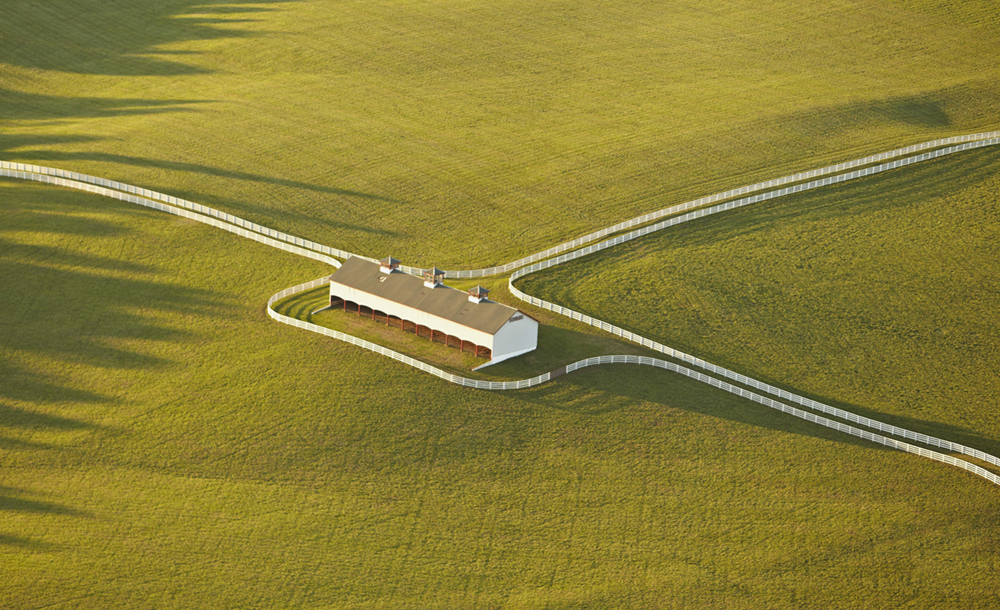Kentucky: Historic Houses and Horse Farms of Bluegrass Country, photographs by Pieter Estersohn, introduction by W. Gay Reading, The Monacelli Press, www.monacellipress.com, 2014; 256 pages, hardcover, $60.
Review by Anne Kugielsky
When the strains of “My Old Kentucky Home” waft over the crowds at Churchill Downs on May 1, prior to the running of the Kentucky Derby, everyone stands and sings and becomes teary-eyed — hearts swell with pride and love for the horses, the state, its history and enduring cultural legacy.
The landscape of bluegrass and elegant houses form an iconic place in the Americans’ hearts. And, in the luxurious volume Kentucky, Pieter Estersohn presents luminous views of the architecture and lands Daniel Boone famously explored and settled.
Estersohn is a preeminent photographer of architecture and interiors. His work regularly appears in major shelter magazines, including Architectural Digest, House Beautiful and Elle Décor, and he has contributed his photographs to numerous interior design and lifestyle books.

Exterior of Elley Villa, once home to a Mississippi planter, a Civil War judge and a Civil War general. It is now owned by Martha and James Birchfield, who have restored both the house and the original name.
Lexington has a rich architectural and cultural history that is manifest in the elegant houses within and around its center. The wealthiest town west of the Alleghenies prior to the Civil War, it was home to Southern gentry, notable politicians, farmers and entrepreneurial settlers relocating from the North.
Estersohn guides us through the historic houses of Bluegrass Country — the legendary landscape of Lexington and its environs. Among the properties presented are Ashland, an Italian-inspired villa built for distinguished statesman and orator Henry Clay; Pope Villa, one of only two extant residences by Benjamin Latrobe, the architect of the US Capitol; Waveland, a completely intact Greek Revival estate from the 1830s; and Pleasant Hill, the largest restored Shaker community in the country.

The open door, symbolic of Lexington’s renowned hospitality, leads into the stair hall where a carved wooden bear from Bavaria and a moose head are from Lamon Vanderburgh Harkness, who bought the property in 1892. The ornate, embossed wallpaper dates from the late 1800s.
Among the 18 properties Estersohn investigates, the earliest is Simpson Farm, Paris, built in 1785 when Kentucky was still part of Virginia. Built of local limestone, the two-story block structure is the original structure and the one-and-a-half story addition was built between 1800 and 1810. The most recently built house Estersohn presents is Gainesway Farm, Lexington, built in 1965. Established by John R. Gaines, Graham Beck purchased Gainesway in 1989 and acquired adjacent properties to form a 1,500-acre breeding farm; the house is set among old-growth trees with a collection of rare oaks surrounding it.
Lexington has a longstanding equestrian heritage that has made this Southern town the Horse Capital of the World. Dramatic aerial photographs celebrate the rolling landscape and expansive horse farms of the land, including Gainesway Farm, which has produced an impressive roster of legendary thoroughbreds.
Kentucky presents a multifaceted portrait of a unique part of our country that combines a reverence for history and Southern tradition with a vital present. Estersohn shows the way the houses and people live today, and the common link is, as W. Gay Reading says in his personal introduction, “the hospitality to be enjoyed at each. Seven sites depicted are open to the public and exhibit interpretations of, and even departure from, the typical ‘house museum’ concept.”
Estersohn has photographed six working farms, where thoroughbred and standardbred horses, cattle and other live stock are cultivated along with other crops and ornamental plantings and gardens. Four of the residences are inside the urban center of Lexington and the Iroquois Hunt chapter reveals the close relationship between people and the land.
Beyond the wonderful photographs of interiors and exteriors, of gardens and barns, sheds and historic structures are the aerial views Estersohn has perfected. Kentucky is a multifaceted and compelling portrait of a unique area of the United States; it is visually stunning and emotionally satisfying — for architecture aficionados, horse lovers, decorative arts and history buffs — this book fits into many collections.
All images copyright ©Pieter Estersohn and courtesy The Monacelli Press.






